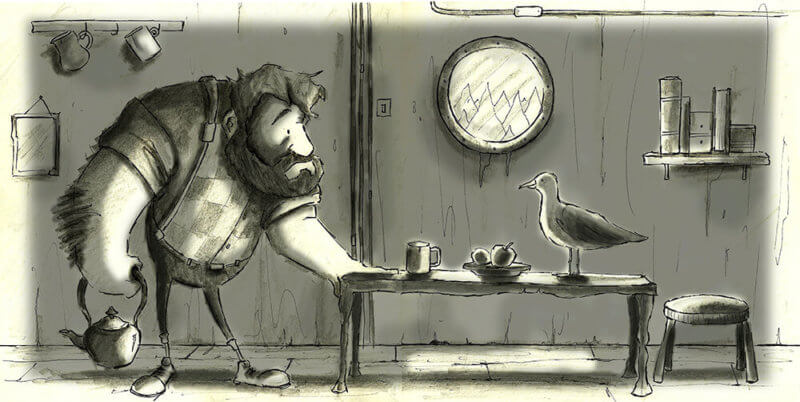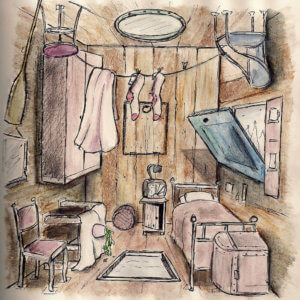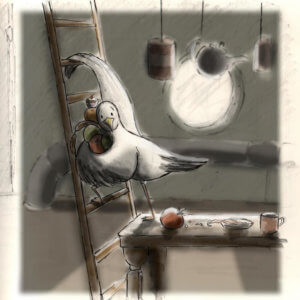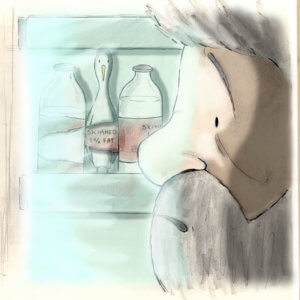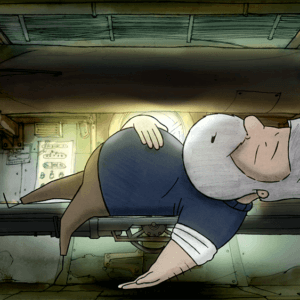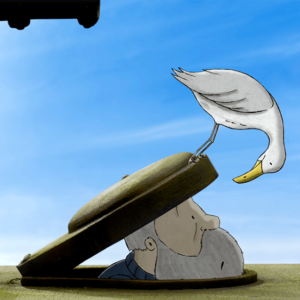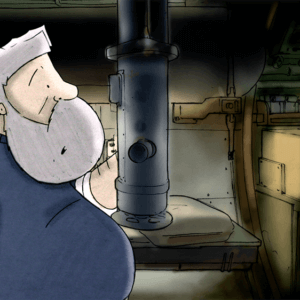Perched
What is the film about?
Perched is a traditional 2D paper animated adventure full of heart and feathers!
‘Hamish Fint, a crotchety old man who lives his life balancing his submarine atop a mountain, struggles to maintain equilibrium when a visiting seagull ‘rocks’ his world.’
What influenced it?
From a young age, I was inspired to work in hand-drawn animation, having grown up with the likes of Raymond Briggs books, Glenn Keane’s paper drawn characters and Joanna Quinn’s energetic yet fluent pencil on paper animation, a traditional style I have since adopted into my film making. I am a collaborator and a passionate storyteller who is always looking for the next tale to tell.
A little background information...
For as long as I can remember I’ve always drawn, it was as if my 2B pencil was an extension of my arm. It wasn’t until I saw The Snowman for the first time in 95′ that I suddenly had the urge to bring my sketches to life. Perched is a culmination of everything I’ve learned throughout my education about animation and the art of storytelling at its most simple yet effective level. The story highlights themes throughout my childhood, an unbalanced life, the need to take a leap of faith; however I chose to make them a little more subtle as my audience was families.
There is something incredibly satisfying about having a film that can bring people together, whether it’s over the festive period with the whole family gathered around the room, or even after a hard day at school and you just want to huddle round the tv and enjoy an adventure together. I missed those moments as a kid which I why I wanted to tell a story that gave people the chance to do exactly that. And I like to think there’s a little something in there for everyone, and it can also be enjoyed by those who speak other languages too as I chose to make the film dialogue free, just like my inspirational film did all those years ago.
How was the film made?
I knew from day one that Perched was to be animated the way I have grown up learning, traditional hand drawn on paper. There is something incredibly magical about the ability to bring a drawing to life. To see the odd imperfections within the line work makes it so personal and yet so unbelievable. Traditional hand drawn has a quality that other techniques just can’t replicate. To work so tirelessly on each drawing, (thousands of them sometimes) but when you put all of those pieces of paper together, you’ve created life on screen.
The other aspect I really wanted to explore was built sets. In order to get incredible scope of the top of the mountain, I really wanted to shoot a space that felt big even to us standing in it. So when Hamish is cramped up inside, I opted to keep the background 2D drawn. Having it flat made him seem more squashed and uncomfortable. Whereas the outside world that is dangerous and unreachable to him, is vast and open. By mixing the two I believe we achieved a real sense of scale which really highlighted the characters predicament and wanting to move on.
What have you been up to since graduating from the NFTS in 2016?
Thankfully I have been a pretty busy freelancer since graduating, working on a variety of projects in various mediums; projects that include children’s animation, music videos, Christmas commercials and live action feature script editing, with clients such as Beano and Channel 4.
In and among the freelance work, I’ve had a wonderful festival tour with ‘Perched’, showing at 150 screenings worldwide, and picking up 40 awards. We even screened the film for the Emir of Qatar which was a pretty special occasion! What was lovely about touring with ‘Perched’ was that our audience was primarily children, and in some cases they were also the judges in competition. Some say children are the hardest critic so it was pretty overwhelming to see their joyful reactions, as well as watching families enjoy the film together.
Along side all that I have been in development on my Children’s tv show ‘Gladys and the Moon’ since 2017 along with my team from ‘Fruition’ here in London. Gladys is a traditional 2D animated show loosely based on the life of my Great-Grandmother which tells the story of an 80 year old pensioner whose aspirations are literally out of this world! The project is still in it’s early stages but we’re hopeful to move on to pre-production very soon. When you’re at the film school, you get a bug for wanting to create new and exciting projects that are your own and Gladys was one of those and I immediately pursued it; but as all graduates know you’ve got to pick up work pretty quick once your time is over so I’m grateful that I’ve been able to sustain my freelance career as well as continuing to develop the show. So in summary, I’m pretty much Hamish in the submarine right now, doing his balancing act!
As someone passionate about working in ‘traditional hand drawn on paper’ animation, do you see this as a viable career choice going forward? Have you been able to find work with this, your preferred technique?
The work I have been lucky enough to be involved with hasn’t really lent itself to traditional animation and those projects that do require it tend to head towards bigger animation companies with more resources. There are some that require hand drawn elements but nothing like what I did in Perched, which is a shame. However, I understand the current climate in the industry which is why most of my work has shifted to digital. If you don’t move with the times, you can get left behind. You need to keep developing your skills so people will hire you but it’s great to have a strong drawing core because that can be molded into a variety of things.
But as you say I am hugely passionate about traditional 2D on paper which is why that is my technique for ‘Gladys and the Moon’. I understand that everything comes down to money in this business and paper drawn animation can be quite costly given digital can cut the cost and speed the process. However I’ve always believed there’s still a place for paper animation because like stop-motion there is a magical element to creating something from nothing. To see the ‘happy accidents’ within the line work and still have people believe in your characters is a wonderful thing. Some digital blockbuster features even insist on putting elements of a ‘human’ touch back into the film, so why not work that way from the start? The beauty of traditional paper animation is its ability to bring generations together, from parents who watched it during their child-hood to their own kids who are experiencing it for the first time. There is a reason people refer to paper animated films as ‘timeless classics’, there is nostalgic value that is hard to replace. I do see it as a viable career moving forward but like most techniques it’ll come back into fashion and hopefully my persistence within my own work will help give it a nudge.


